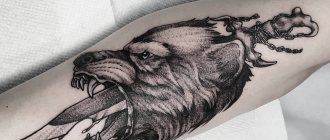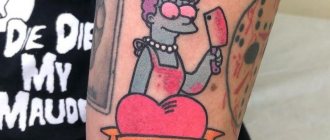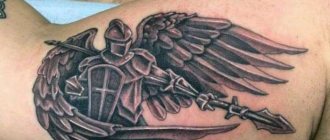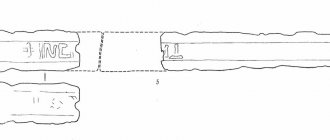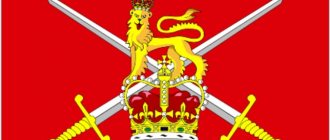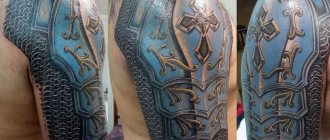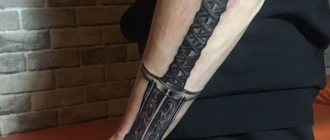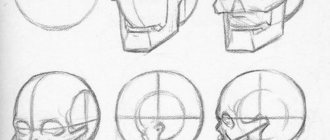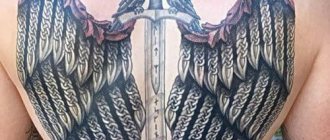People began to make swords in the Bronze Age, quite often ornamenting them richly, which indicates their not only functional purpose as a weapon. In ancient China, it was believed that with this weapon a wizard could cast out demons, and if a woman dreamed that she was pulling a sword from the water, it meant that she was to have a son. However, in the event that a man had a dream in which a blade fell into a lake, he was to expect the imminent death of his wife.
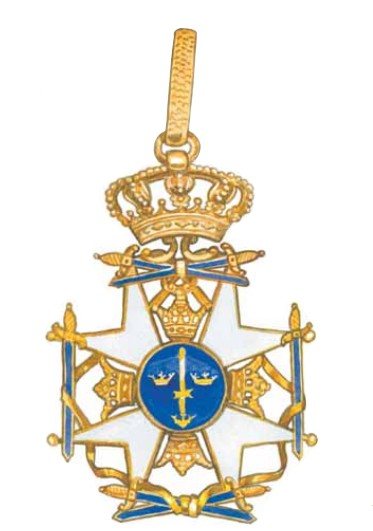
The Swedish Order of the Sword
In the Greeks, the legend of Damocles, a favorite of the Syracuse tyrant Dionysius I, is associated with this symbol. The tyrant placed him on the throne for a day, and hung a sword over his head on a horsehair, so that Damocles would realize the illusory nature of the ruler's happiness and well-being. In Christian tradition and chivalry, the sword is the supreme weapon of the warrior.
Crusaders had a cult of this weapon: sticking the sword in the ground, the knight prayed to it as a cross, in its hilt were often placed holy relics. For example, the hilt of Durandal, the legendary sword of paladin Roland, had a tooth of St. Peter, a vessel with the blood of St. Basil, a hair of St. Denis and a piece of the robe of the Virgin Mary.
This weapon was believed to be endowed with a special power, uniting spirit with matter, and was also a symbol of duty and completeness. The sword of the French king, with which he dedicated knights, symbolized the vertical axis linking heaven and earth, thus indicating to the ruler his duty to be truly just, by which he could maintain the eternal order of things. The sword of the knight was double-edged, as one blade he has to destroy the infidels, and the other - the thieves and murderers. This symbol was also the embodiment of the Passion of the Lord and martyrdom, a sword with a transition to the crucifixion hilt - an attribute of Christ.
The symbolism of many Christian saints also contains this weapon.
Junior arcana "King of Swords" from the Tarot deck of the Duke of Visconti, 15th century.
St. Martin of Tours cut his cloak with a sword to give part of it to the poor, and the image of the Virgin Mary with seven plunging into her chest blades represents her seven woes.
In Japan, the sword had a special place: this weapon, which is in the tail of the Great Dragon, along with the mirror and jewels, is the treasure of the imperial throne.
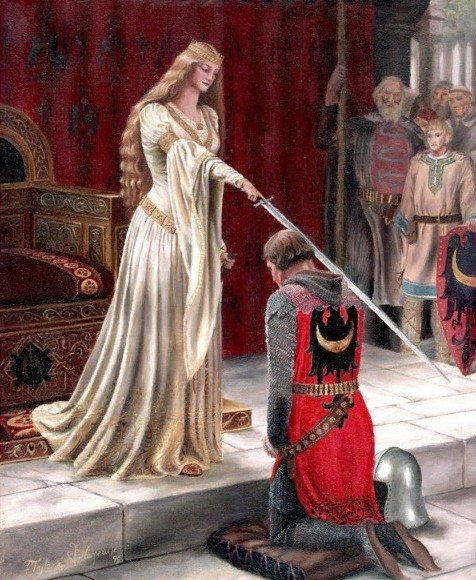

Medieval rite of initiation into knighthood
The sword symbolizes the simplest solution to any problem. The ancient Greeks had a legend about King Gordia, who tied a very complicated knot that only a true ruler of Asia could untie. Alexander the Great could not untie this knot, and then he simply cut it with his sword.
A sword in its scabbard was considered an attribute of moderation. A sword thrown on the scales signified increased demands through military pressure. This symbol went from the Gallic chief Brennus, who conquered Rome. When the Romans weighed the gold for the contribution, he threw his blade on the scales, declaring, "Woe to the vanquished.
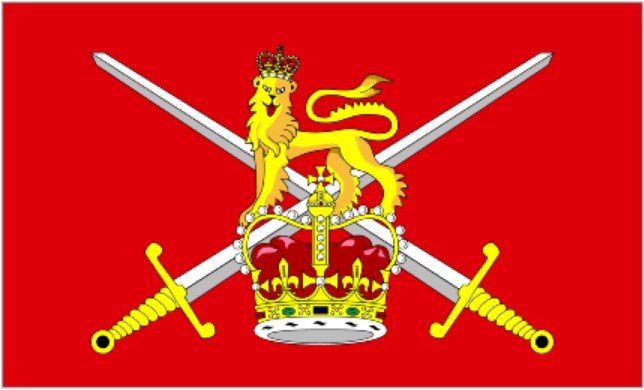

The flag of the Armed Forces of Great Britain. Two crossed swords are an ancient symbol of war and military prowess
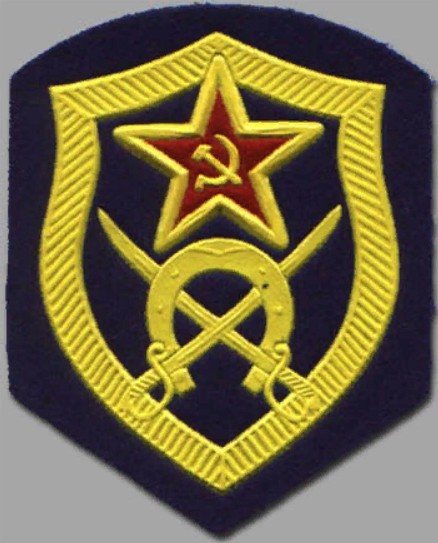

USSR cavalry armband
Royal regalia
A sword is the emblem of the monarch's power. It was believed that such a blade was given to the ruler by the Higher Powers, and in this connection there were many legends that told about the difficult trials that the future king had to go through in order to obtain such a symbolic weapon. For example, the sword Excalibur was magically placed in a stone, and King Arthur was the only person who could get it. Another famous blade of Albion is the blunt sword of St. Edward the Confessor Curtan, which became a symbol of mercy. It is still solemnly worn in processions during the coronations of British kings.
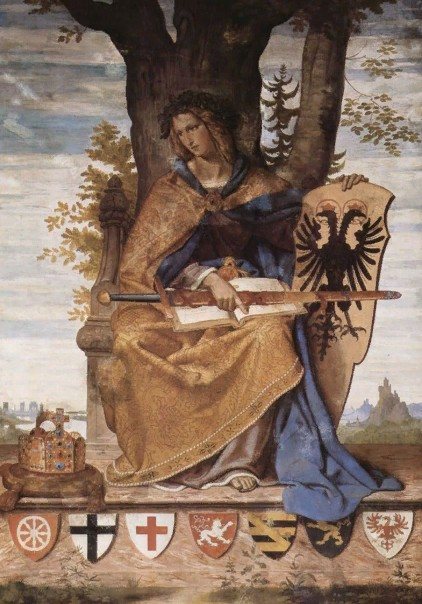

Ф. Feith. Germany
What was a sword for a medieval knight? Was it only a weapon?
A knight could break a lance, lose a horse, throw away a shield, but a sword... "As for a knight a sword," so they say about the most precious thing for a man. Not without reason has the idiom "to break the sword" forever become synonymous with defeat.
Of course, during the time of King Arthur (the beginning of the XII century), and much later, along with the sword were used many types of other weapons. For example: spear, axe (battle axe), dagger, chain, pernach, mace, mace, checan - narrow battle hammer on a long handle (also known as cleaver), morgenstern - spiky ball attached by a short chain to a wooden hilt.
A spear is uncomfortable in close combat, especially on foot, and is easily broken. And what about the other kinds of weapons? Let us imagine the following situation: there are two foot soldiers in a one-on-one field: one is armed with a shield and a sword, the other with a shield and a chaser, or option one with a morgenstern and a shield. Who will win?
Of course, the element of professionalism and military luck no one, not even the Lord God, can cancel. Still.
1. the shield cannot be destroyed by a sword blow. At best the sword will blunt, at worst it will break, it can also get stuck in the shield. If you try to cut through the armor with a blunt sword, it won't work...
2. The chaser does not get stuck in the shield - it pierces it and that's it. In addition, neither helmet nor armor saves from a punch; missing the punch, the warrior immediately gets a severe concussion.
3. Strength must also be saved in combat: neither morgenstern, nor chekan weigh more than a sword. Their weight is 1.5 to 3 kg at most. But they hit with a limited surface and their penetration is very high compared to the sword.
4. The only advantage of a sword is that you can stab with it, but the same swords often had a sharp tusk on top - you can stab with it, too, like with a very short spear. So the sword's advantages were negligible, especially against the armor, which perfectly protected against sliding blows.
5. Morgenstern creates life-threatening contusions. Even blows to the shield with a morgenstern are dangerous, they can create severe bruises to the hand that holds the shield, and the shield hangs on a stationary hand...
6. Both the morgenstern and the chaser are extremely dangerous when struck in the head, they are almost impossible to beat off - especially with the chaser. Lifting the shield that high every time would make your arm tired. And trying to beat off the morgenstern with a sword will leave you without a sword... by entangling the sword with the chain, it's very easy to snatch it from the opponent. And the sword will be much less effective in this situation - it slips off the helmet's surface, it doesn't cause any concussion, it cuts through the helmet on the head worse...
These are the considerations...
By the way, all these weapons were much cheaper than the sword. So maybe the sword was just for show? For a medieval warrior on foot, the sword was more of an auxiliary weapon.
The equestrian warrior is a different matter. The speed with which equestrians come close does not allow for multiple strikes - often a single strike decided who would win. The spear usually broke down by the middle of the battle. By the way, the cutting counter-strike with the sword of a cavalryman is much stronger than that of a standing infantryman. A good stabbing blow to an enemy rushing at high speed would pierce any armor. Infantrymen can stop the cavalry only a dense pike formation, in all other cases the mounted warrior has an undeniable advantage over the foot. And it is the sword more convenient to break through a dense line of infantry.
In the Crusades Crusader knights faced with light cavalry Arabs - the Sarracens, whose main weapon was a crooked saber. But they did not adopt it, as, for example, the ancient Romans adopted the Spanish saber. The light bulat saber, easily cutting nails, was powerless against the armored knights. And the stabbing or chopping blow of the sharp, tapering to the end of the heavy one and a half meter steel blade easily pierced any Arab armor, including the shield. And it is easy to pray to ask for God's mercy, all you have to do is stick your sword in the ground. Here was a marching altar with a cross...
And as a status symbol, the sword had no equal! The high cost of a good long sword (compared to other weapons) makes it accessible only to wealthy people. A sword was always with its owner, and by it you can easily determine with what social level you are dealing. Consequently, it was the sword that distinguished the knight from the mass of other people, symbolizing his social superiority.
A man who was good with a sword did not stay long at the bottom of the social ladder. By the way, the initiation of knights in those days was also done by the sword. At the initiation, some "sacred" manipulation was done over the initiate: to slap him on the shoulder with the side of the blade, or to do something like that.
And here is the answer to the question in the title.
"A sword is not just a tool for a knight, like an axe for a carpenter or a trowel for a stonemason. It is a friend. Because it not only protects but also feeds. Try not to give it the attention it deserves - it will let you down in a difficult time. It gets stuck in the enemy's bone, wrenches out of his hand... It jams in its sheath... You never know. A sword should be cherished and nurtured. Sharpen it with a donkey, lubricate it in wet weather. And, of course, practice, practice, practice! After all traveling knights are forced to rely only on the strength of their arms, sword and spear and luck and the grace of God. Vladislav Rusanov. "The Passion of Destiny".
It went on like this until cannons and infantry armed with firearms appeared. The heavy, armored, clumsy cavalryman was an excellent target. A sword gradually "degenerated" into a graceful sword, which the men of the nobility wore many years (even centuries) later.
Tags: sword, symbols, warrior, weapons, chivalry, history
Sword in heraldry
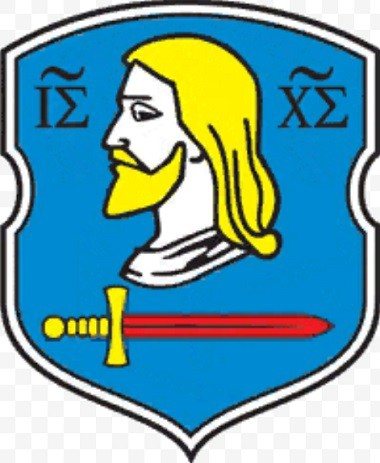

Sword under the image of Savior on the emblem of the Belarusian city of Vitebsk symbolizes the wrath of God
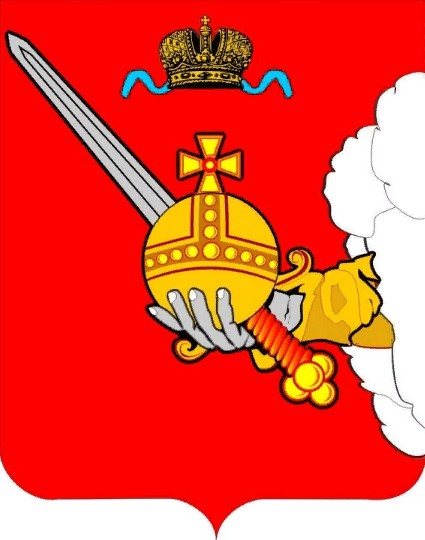

Arm with a sword on coat of arms of Russian Vologda symbolizes justice and defense of Fatherland
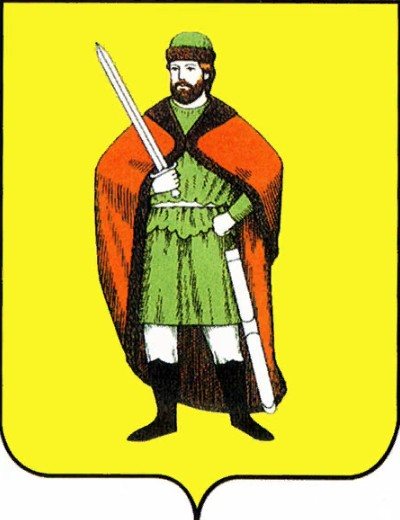

The coat of arms of the Russian city of Ryazan depicts a prince with a silver sword in his hand
Sword of Allah
Sword is one of the oldest and best known symbols of Islam. It traces its roots back to the legendary sword of Prophet Muhammad Zulfiyar and later his adopted son Ali. It is believed that Imam Hussein ibn Ali was armed with this blade during the Battle of Kerbala. In Islamic iconography, the image of Zulfiyar was used as a symbol of honor and chivalry. In Muslims, the sword also symbolized the holy war of the faithful against the infidels, and at the same time the struggle of man against his own evil.
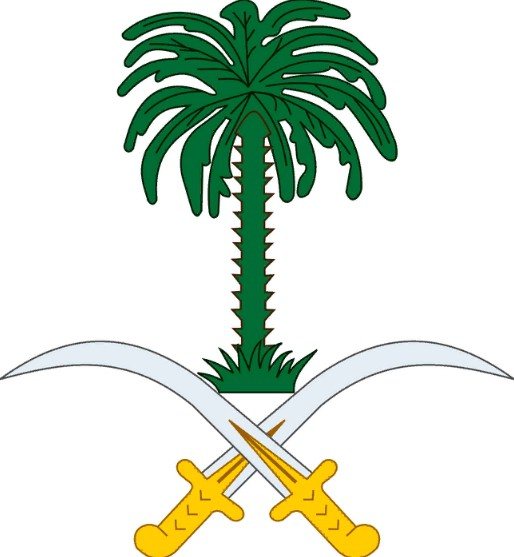

The coat of arms of Saudi Arabia
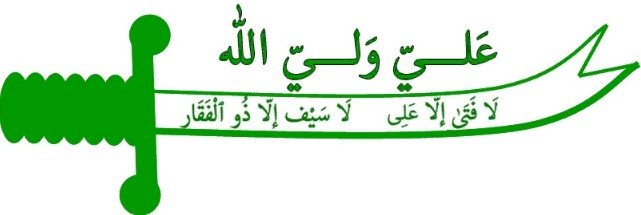

The symbolic image of the sword of Allah and the first caliph Ali
Not the world, but the sword
The sword as a symbol plays a prominent role in the New Testament. The apostle Peter, a former fisherman, is armed with a sword. He was the only one of the disciples who stood up for the Lord when he was arrested and cut off the guard's ear. He put down his sword only at Jesus' command. Peter's action became a symbol of his willingness to lay down his life of faith without hesitation. Some theologians have suggested that the Apostle's subsequent threefold denial of Christ was Peter's attempt to save the Savior's life.
In the Revelation of John the Evangelist the sword comes out of Christ's mouth as a symbol of the invincible truth in heaven, which is like lightning falling from heaven. In Matthew's Gospel Jesus says, "I have not come to bring peace, but a sword." This biblical expression became especially popular during the Reformation era in Germany and became the motto of the peasant war led by Thomas Münzer. Guided by this slogan, the rebels waged a religious war for the ideals of radical reformation. Today the sword Münzer wore before his army is on display in a museum in the German city of Alstedt.
Masaccio. St. Peter.
Indian subcontinent
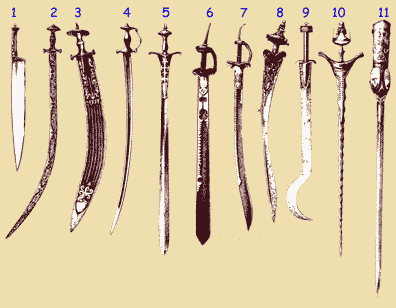

The region of India and adjacent regions is rich in a variety of sword types. The best steel blades in the world with luxurious decorations were made in India. In some cases it is difficult to give a correct name to some sample blades, to determine the time and place of their manufacture, so a thorough study of them is yet to come. The dates indicated refer only to the specimens depicted.
- Chora (Khyber), a heavy single-bladed sword of Afghan and Pashtun tribes. Afghan-Pakistani border.
- Tulwar (Talwar). A sword with a curved blade and hilt with a disc-shaped tip, India. This specimen was found in North India, 17th century.
- A thulwar with a broad blade. Was a hangman's weapon. This specimen is of North Indian origin, XVIII-XIX centuries.
- Tulwar (Talwar).Punjabi style steel hilt with a safety shackle. Indore, India. Late 18th c.
- Khanda, steel hilt with gilding in the "Old Indian" style. A double-edged straight blade. Nepal. XVIII century.
- Khanda. Handle in the "Indian basket" style with a branch for grasping with both hands. Marathi people. XVIII c.
- Sosun puttah. Handle in "Indian basket" style. Forward curved reinforced blade with one blade. Central India. XVIII century.
- South Indian sword. Steel hilt, square wooden tip. The blade is curved forward. Madras. 16th century.
- Sword from the Nayar Temple. Brass hilt, double-edged steel blade. Tanjavur, South India. XVIII century.
- South Indian sword. Steel hilt, double-edged wavy blade. Madras. XVIII century.
- Pata. Indian sword with a gauntlet, a steel guard protecting the hand up to the forearm. Decorated with engraving and gilding. Aud (now the state of Uttar Pradesh). 18th century.
- Adyar katti of typical form. Short heavy blade curved forward. The handle is made of silver. Coorg, Southwest India.
- Zafar takeh, India. Attribute of the ruler at the audience. The handle's tip is in the form of an armrest.
- Firangi ("stranger"). This name was used by Indians for European blades with Indian hilt. This shows a Maratha sword with a 17th century German blade.
- Double-edged double-edged sword with hollow iron tips. Central India. 17th century.
- Bark. The blade is curved forward, has a single blade with a "pulled back" tip. Nepal. XVIII c.
- Kukri. Long narrow blade. Was widespread in the 19th c. Nepal, circa 1850.
- Kukri. Iron hilt, graceful blade. Nepal, circa 19th c.
- Kukri. Was in service with the Indian army in World War II. Manufactured by a contractor in North India. 1943 г.
- Ram Dao. A sword used for animal sacrifice in Nepal and northern India.
